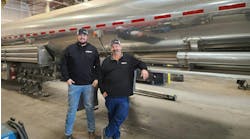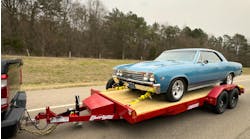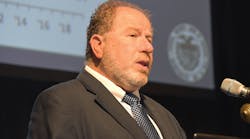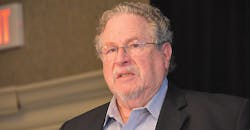Managing the marketplace: No need to turtle up in this ‘tortoise’ economy – recession remains a distant consideration
The United States enjoyed the longest period of economic expansion in its history in the 1990s – a record 120 consecutive months.
That mark might not last much longer.
Gross domestic product expanded over the past year by 2.9%, which is well above trend growth—a combined measure of labor force and activity growth—and most indicators point to continued gains.
“If this economy continues to expand through the middle of next year, we will match that (record, set from 1991 to 2001),” said William Strauss, a senior economist and advisor with the Federal Reserve Bank of Chicago.
“So, if we go into July with growth continuing, we will set a record for this expansion, and that’s a very good possibility.”
Some issues remain, including rising interest rates, trade and tariff anxieties, and the global economy—the US is in the best shape of any country right now—but the experts on hand at the 2018 FTR Transportation Conference including Eric Starks, chairman & CEO of FTR, Eli Lustgarten, president of ESL Consulting, and Jeff Kauffman, president of Tahoe Ventures, agreed the threat of recession remains a distant concern for truck and trailer manufacturers.
“The smart people are saying the risk of recession has been reduced,” Strauss said.
The Fed’s take
Strauss, a leading economist in the industrial sector, called the current economy, with its moderate, slightly-better-than-trend performance, a “tortoise,” economy, with well-balanced marketplace activity that leaves little cause for concern domestically through 2018 and well into next year.
The Chicago Fed National Activity Indicator shows continued economic growth in the third quarter of 2018, but closer to trend, which is 2.0%, and the Federal Open Market Committee (FOMC) expects GDP to grow well above trend the rest of this year, slightly above trend in 2019 and at trend in 2020.
Tax reform, and resulting stimulus, accelerated growth, Strauss said, making recession less likely because the economy can absorb more downturn, and employment increased by more than 2.3 million jobs over the past 12 months, leading to an unemployment rate less than 4% on four readings this year.
“This is a very, very low unemployment rate,” Strauss said.
“What is expected? The FOMC anticipates that these unemployment rates actually will move lower this year, and that’s a relationship known as Okun’s Law, which says when your economy’s growing faster than trend, unemployment rates go down, and in fact it continues to tick lower next year.
“Why? Because the economy’s still growing, just a hair faster than trend.”
With lower unemployment comes rising wages and benefits, which will continue to increase at a moderate rate, Strauss said.
“This has not been the most rewarding part of the economy for many people,” he said.
Increased employment plus slight wage gains (after 2% inflation), means improved productivity, too, Strauss said. Productivity growth has been slow thus far but is expected to go higher as companies continue to raise wages, as they’ve indicated they’ll do, likely within the next nine months, in the National Federation of Independent Businesses’ Small Business Optimism Index.
“Is that going to be costly for our businesses?” Strauss said. “We’ll have to wait and see what happens with the other aspect of our economy, which is productivity, and productivity has been challenged.
“It has been abysmal, relatively speaking, over the expansion.”
Improved productivity will keep unit labor cost growth down, even with employee compensation rising.
“If the capital investment fosters greater productivity growth, you can afford to pay your workers more and not have to raise prices for your products, and not have to impact profitability of the corporation,” Strauss said. “So productivity really is the key thing to be looking at with regard to inflation and profits.”
Strauss said corporate profits are increasing but inflation has moved above the Fed target of 2%, following the pattern of energy prices. Natural gas prices remain low, and oil imports have reduced while exports surge, increasing from 1 million barrels a day to more than 7 million over the last decade.
“We are becoming less and less energy dependent on other countries,” Strauss said.
Spurred by rising energy prices and capital investment, manufacturing output is increasing at a “solid pace,” he said.
Capacity utilization is just over 76 percent, and trending upward.
“While it is moving higher, it is still below the roughly 79 to 80 percent we think of as more fully utilized,” he said. “But as we’re moving closer and closer to that, it’s a signal for businesses, when they’re looking at their plant floor, to say they’re using up their equipment ever increasingly.”
Now is a good time to invest in new equipment, too, he said, with machinery investments that will “blow your socks off.”
Manufacturing employment increased by 254,000 workers over the past 12 months, and Purchasing Manager Indexes suggest the US, boosted by strong industrial growth, boasts the world’s strongest economy, even with the barrage of devastating hurricanes, which historically are good for GDP.
And while car sales are down, year-to-date light trucks sales are up 8.8%.
The Fed doesn’t see a trade war causing any legitimate concern about a recession, but it is steadily raising interest rates, with the federal funds rate increasing by 1.75% since December, 2015.
Strauss said the Fed isn’t “putting brakes” on the economy, it’s “taking its foot off the accelerator” as rates move closer to a level slightly above what it considers a neutral stance of 2.8% to 3%.
“In 2020, we begin to tap on the brakes of the economy,” Strauss said. “Why? You can’t ignore those unemployment rates. In my personal view … the unemployment rates remaining as low as they are could begin to put some pressure on the inflation aspect. So it’s possible, but it’s far out there.”
FTR’s perspective
Starks supplied a big-picture risk analysis, comparing current GDP, inflation, the Federal Reserve’s response and manufacturers’ reactions to historical trends to gauge the likelihood of a recession.
In his hypothetical forecast, inflation continues to rise and the Fed reacts to the pressure by increasing interest rates but overshoots the mark, which creating an economic slowdown as rates decrease.
Ultimately, for shippers and manufacturers, that would cause the economy to shrink for a couple quarters, but not at an alarming level—or anywhere close to the Great Recession that hit in 2008.
“If this is what a recession could look like based upon the inputs … what does this then do to the industrial sector?” Starks said. “Well, this suggests we would see industrial production coming down, on a quarter-over-quarter basis, about 5% for a couple quarters. But this is not anything noticeably different than what we have traditionally seen in a normal type of recession environment.
“So, ultimately, the takeaway from this right now suggests that because there’s no radical imbalance within the economy, seeing something similar to what we saw in the Great Recession is very unlikely.”
Even a mild recession is unlikely to occur soon, Starks said.
FTR, with alternate inputs, still sees industrial production, and truck, rail and intermodal freight growth in the black into 2020, making it “very difficult” to envision a recession within the next year.
How should manufacturers react?
“Our general suggestion is that over the next six to 12 months, you really need to be putting some things in your back pocket to be able to pull out if we do start to have inflationary pressure kicking in,” Starks said.
Starks, unlike the Federal Reserve, is worried about the potentially negative impact of a prolonged trade war, which is where he sees inflationary concerns coming from, saying it could impact the freight market, but strong marketplace fundamentals are keeping anxiety at a minimum.
Alternate outlook
Lustgarten, a Wall Street veteran, aired his concerns, including the possible economic effects of a trade war with China and the election of a Democratic congress, while agreeing with the Fed and FTR about the overall strength of the US economy, which he expects to remain robust well into 2019.
Second-quarter 2018 GDP growth “painted a very healthy picture of economic activity,” Lustgarten said, including strong business investment, a rebound in consumer spending and inventory reduction, providing a solid foundation for continued GDP gains next year.
“Manufacturing and consumers are driving the momentum of the economy,” he said.
The Institute for Supply Management’s Purchasing Managers Index remains high, indicating growth in new orders, production and supplier deliveries – all positive for the truck and trailer industries.
“High levels of ISM mean improving industrial production and capacity utilization,” Lustgarten said. “And that drives higher capital spending, which is the natural flow, and it’s key to this economy.”
Uncertainty begins to cloud the 2019-2020 outlook as risks rise. But tariffs, Lustgarten said, are not as big a concern as some fear.
“No matter what you do … you’re going to look at much higher commodity prices the rest of this year and next year, and it doesn’t matter what happens with tariffs,” he said.
Interest rate increases raise the probability of an inverted yield curve—where long-term debt instruments have a lower yield than short-term debt instruments—which is a good predictor of recession, but Blue Chip Economic Indicators say the US economy won’t reach an inverted yield curve.
Lustgarten agrees, but says it will be close.
A key to continued expansion is immigration, which is the primary force driving the labor growth rate, so rational immigration policy is important, and something to keep an eye on with current administration.
But he’s most worried about issues abroad, including China’s slowing economy, monetary policy changes and rising oil prices.
“There are real issues about growth rates outside the United States,” Lustgarten said.
Domestically, Lustgarten worried about upcoming elections resulting in a Democratic Congress, which he said could reverse current fiscal policy gains and bring government to a standstill.
“Forget your politics,” Lustgarten said.
“If you put in a Democratic congress, nothing will happen … and if you start to roll back some of the policies, it will create a mess and … you get issues everyone will worry about, investment will be curtailed, and that’s how you fall into a much weaker economic environment, if not recession.”
Market view
In trying to assess the overall economic mindset and sentiment, Kauffman cited the stock market’s record gains, indicating people are feeling good about their finances and willing to take risks.
“I don’t think the market is grossly overvalued,” he said. “I think the run in the markets has been supported by earnings.”
His concerns include the slowing housing market, political issues that could drag down economic growth and rising interest rates, but he said “signposts remain positive,” despite mixed signals.
“2019 is probably going to be a pretty good year, even if things slow down,” Kauffman said.
That’s music to the ears of truck and trailer manufacturers.
FTR’s original 2018 forecast from two years ago called for shipments of 264,000 Class 8 trucks. That was revised to 285,000 last year and 309,000 this year. Revisions are more dramatic for 2019, with a 19% increase from the original prediction of 270,000 to the current estimate of 335,000.
Trailer estimates for 2019 also are up, though not as dramatically, going from 275,000 two years ago to 300,000 this year.
“The big changes in the FTR forecast have really been the 2019 … and a lot of that is demand we’re not getting to this year,” Kauffman said. “Corporate profit’s very high. I’ve been surprised at how many trucks have been ordered, because the manufacturers aren’t capable of delivering that, but to some degree, once you get over six months of backlog, people … start throwing orders in the system.
“Nobody will admit to it, but the reality is, if you want a truck today, you’re looking at second quarter 2019 for delivery date, so you want to put that order in and get a place in line.”












